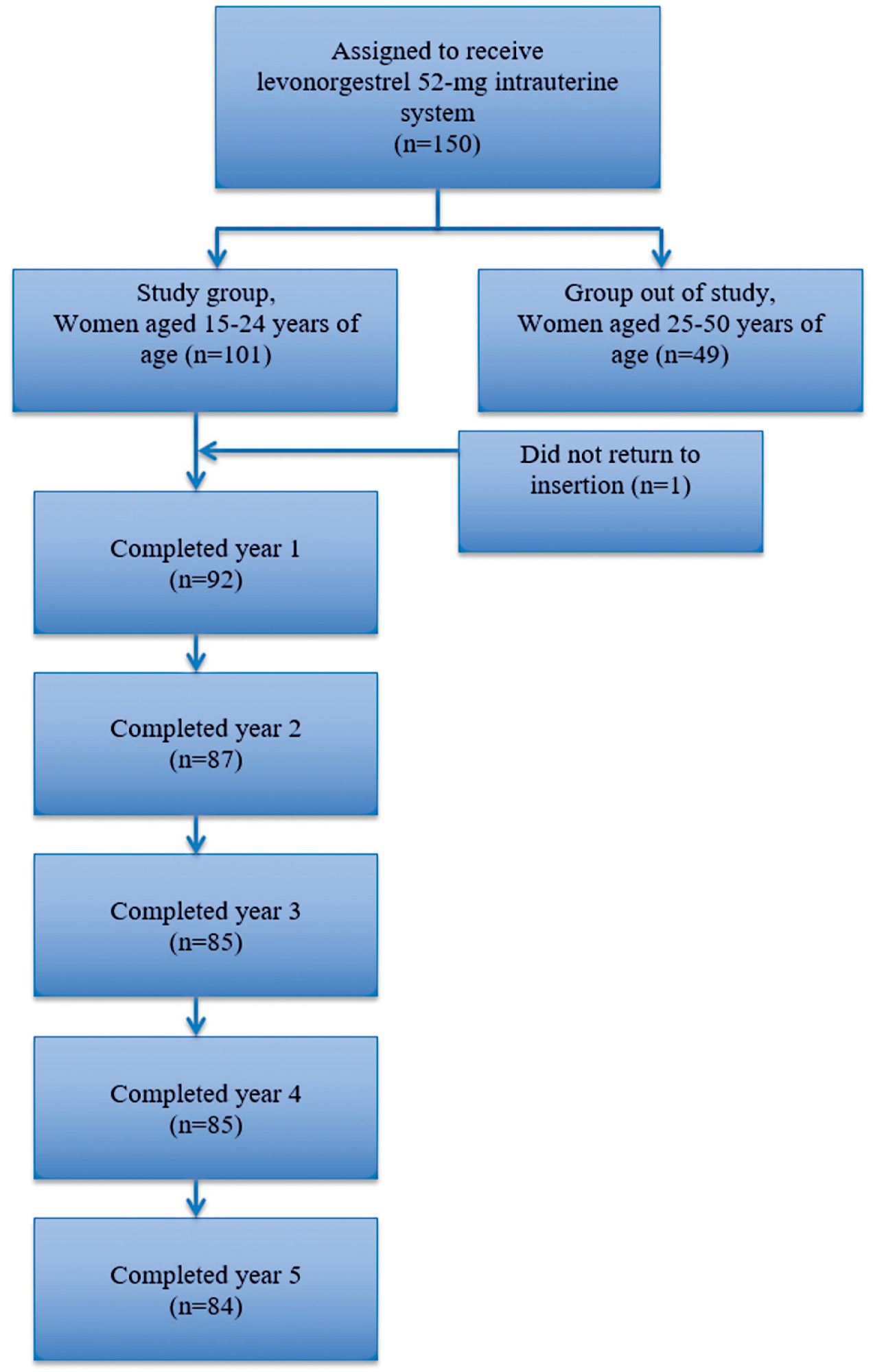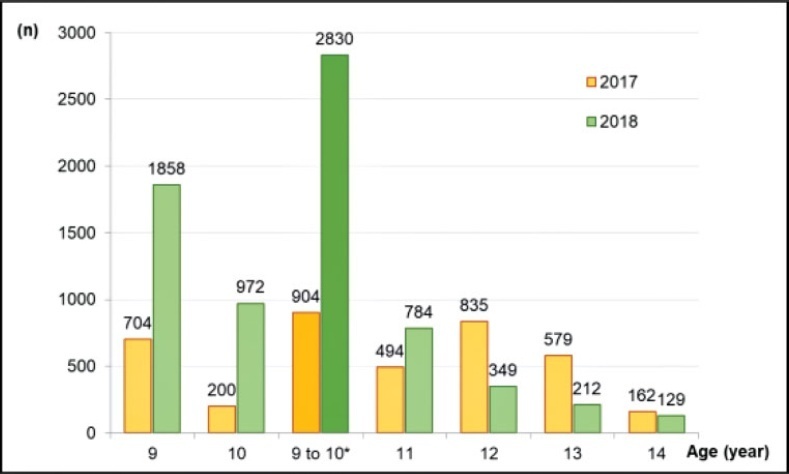-
Original Article/Contraception
Five-year Contraceptive Use of 52-mg Levonorgestrel Releasing Intrauterine System in Young Women, Menstrual Patterns, and New Contraceptive Choice
Revista Brasileira de Ginecologia e Obstetrícia. 2023;45(11):654-660
12-05-2023
Summary
Original Article/ContraceptionFive-year Contraceptive Use of 52-mg Levonorgestrel Releasing Intrauterine System in Young Women, Menstrual Patterns, and New Contraceptive Choice
Revista Brasileira de Ginecologia e Obstetrícia. 2023;45(11):654-660
12-05-2023Views119Abstract
Objective
To evaluate the continuation rates of the 52-mg levonorgestrel-releasing intrauterine system (LNG-IUS) during the first 5 years of use, reasons for its discontinuation, bleeding patterns, and new contraceptive choice after the 5th year, in adolescents and young women.
Methods
The present study was a 5-year prospective cohort conducted in a Family Planning Service of a tertiary hospital in Brazil. We selected 100 healthy women between 15 and 24 years old who used 52-mg LNG-IUS for contraception. The clinical follow-up of these women took place from June 2017 to December 2022. The study evaluated the continuation rates of the method, reasons for its discontinuation, bleeding patterns, and new contraceptive choice after the 5th year. Continuous data were reported as mean ± standard deviation (SD) and range (minimum-maximum). Categorical variables were described as percentages.
Results
The continuation rates of LNG-IUS were 89.1% (82/92), 82.9% (72/87), 75.3% (64/85), 70.5% (60/85), and 64.2% (54/84) in the 1st, 2nd, 3rd, 4th, and 5th years of use, respectively. The main reason for discontinuation was acne (11/30). Amenorrhea rates were 50, 54.1, 39, 35.7, and 51.8% at 12, 24, 36, 48, and 60 months, respectively. All patients who completed the study and needed contraception after the 5th year opted for long-acting contraceptive methods (LARC).
Conclusion
The LNG-IUS showed high continuation rates in adolescents and young women in the first 5 years of use. Most patients who completed the study chose a LARC method after the 5th year.
Key-words AdolescentsAmenorrheaContraceptionlevonorgestrel intrauterine systemlong-acting reversible contraceptionMenstruationSee more
-
Original Article
School-based HPV Vaccination: The Challenges in a Brazilian Initiative
Revista Brasileira de Ginecologia e Obstetrícia. 2021;43(12):926-931
01-24-2021
Summary
Original ArticleSchool-based HPV Vaccination: The Challenges in a Brazilian Initiative
Revista Brasileira de Ginecologia e Obstetrícia. 2021;43(12):926-931
01-24-2021Views193See moreAbstract
Objective
The present study assesses the implementation and the impact after 2 years of a school-based human papillomavirus (HPV) vaccination program in a Brazilian city.
Methods
A prospective study assessing the implementation of the program, offering quadrivalent HPV vaccine in two annual doses to girls and boys aged from 9 to 10 years old. The program was started in the city of Indaiatuba, state of São Paulo, Brazil, in 2018, and had authorization from the National Immunization Program. The number of HPV vaccine first doses applied and the coverage in 2018 was calculated and compared to the year 2017. There were described events that have influenced the results.
Results
The program invited 4,878 children through schools (87.1% of the target population), and 7.5% refused vaccination. Several concurrent events required or competed for health professionals of the vaccination teams. The coverage of the first dose (between 9 and 10 years old) was 16.1% in 2017 and increased to 50.5% in 2018 (p < 0.0001). The first dose in all ages increased 78% in 2018 compared with 2017 (6,636/3,733). Competing demands over the program continued in 2019, and the first dose coverage dropped (26.9%). For 2020, a municipal law instituted school-based vaccination and the creation of dedicated teams for vaccination, and these strategies are waiting to be tested.
Conclusion
School-based annual HPV vaccination in children between 9 and 10 years old was feasible and increased vaccination coverage, regardless of gender, although the program was vulnerable to competing events.

-
Original Article
Effectiveness of Counseling Based on Functional Analytic Psychotherapy with Enhanced Cognitive Therapy on the Sexual Quality of Life of Married Adolescent Women
Revista Brasileira de Ginecologia e Obstetrícia. 2021;43(7):513-521
10-18-2021
Summary
Original ArticleEffectiveness of Counseling Based on Functional Analytic Psychotherapy with Enhanced Cognitive Therapy on the Sexual Quality of Life of Married Adolescent Women
Revista Brasileira de Ginecologia e Obstetrícia. 2021;43(7):513-521
10-18-2021Views119Abstract
Objective
Early marriage has many deleterious effects on the health of girls, such as sexual dissatisfaction, an inevitable result of the lack of sufficient knowledge about sexual issues at the time of the marriage. The goal of the present study was to determine the effectiveness of counseling based on functional analytic psychotherapy with enhanced cognitive therapy (FECT) on the sexual quality of life of married adolescent women.
Methods
This clinical trial was conducted between July and October 2019 on 150 married adolescent women who met the inclusion criteria. In the intervention group, FECTwas conducted in sixteen 90-minute sessions twice a week. The Sexual Quality of Life-Female (SQOL-F) questionnaire was used. When the study ended, the control group was given the choice of receiving the same intervention as the intervention group.
Results
The paired t-test showed a significant difference between the mean score of sexual quality of life before (52.33±23.09) and after (88.08±10.51) counseling in the intervention group (p<0.0001). According to the analysis of covariance, there was a significant difference between the score on sexual quality after counseling between the intervention (88.08±10.51) and control (60.32±23.73) groups (p<0.0001). There was also a significant difference between the mean score on the four dimensions of sexual quality of life in the intervention group (p<0.0001).
Conclusion
The results showed that counseling based on FECT improved the sexual quality of life in all dimensions in married adolescent women.
Key-words Adolescentscognitive behavioral therapy (CBT)functional analytical psychotherapy (FAP)married womensexual quality of lifeSee more -
Short Communication
Nutritional Counseling Promotes Changes in the Dietary Habits of Overweight and Obese Adolescents with Polycystic Ovary Syndrome
Revista Brasileira de Ginecologia e Obstetrícia. 2017;39(12):692-696
12-01-2017
Summary
Short CommunicationNutritional Counseling Promotes Changes in the Dietary Habits of Overweight and Obese Adolescents with Polycystic Ovary Syndrome
Revista Brasileira de Ginecologia e Obstetrícia. 2017;39(12):692-696
12-01-2017Views147See moreAbstract
Objective
To evaluate the effects of nutritional counseling on the dietary habits and anthropometric parameters of overweight and obese adolescentswith polycystic ovary syndrome (PCOS).
Methods
This was a prospective, longitudinal and auto-controlled study. Thirty adolescents aged 13-19 years-old, diagnosed with PCOS received nutritional counseling and were followed-up for 6 months. After the follow-up period, the results were evaluated through body weight, body mass index (BMI) and waist circumference (WC).
Results
Sixty-percent of the adolescents adhered to the nutritional counseling and, of these, 50% lost weight. Adolescents who lost weight changed their dietary habits by adopting hypocaloric diets and eating more meals per day, as per nutritional counseling. The waist circumference (WC) decreased significantly, although the body weight decreased non-significantly after adoption of a hypocaloric diet.
Conclusion
Although there was no significant weight loss, there was a considerable reduction in theWCassociated with hypocaloric diets and with eating a greater number of meals per day.
-
Original Articles
Adolescent Contraception Before and After Pregnancy-Choices and Challenges for the Future
Revista Brasileira de Ginecologia e Obstetrícia. 2016;38(11):545-551
11-01-2016
Summary
Original ArticlesAdolescent Contraception Before and After Pregnancy-Choices and Challenges for the Future
Revista Brasileira de Ginecologia e Obstetrícia. 2016;38(11):545-551
11-01-2016Views82See moreAbstract
Objective
To determine methods of contraception used by adolescents before and after pregnancy.
Methods
A cross-sectional study was performed, and data were collected from medical records of all teens in puerperal consultation at the Hospital da Mulher - José Aristodemo Pinotti (Caism), Universidade Estadual de Campinas (CAISM), São Paulo, Brazil, between July 2011 and September 2013. The inclusion criterionwas being 10 to 19 years old, and the exclusion criterion was having a first consultation 90 days after childbirth. Statistical analyseswere performed with averages, standard deviations, percentages, correlations and Fisher's exact tests using the SAS program, version 9.4.
Results
A total of 196 adolescents in postpartum consultation were included (44 days after childbirth on average). The majority was older than 14 years (89%), with an average age of 16.2 years, and the most were exclusively breast-feeding (70%). Before pregnancy, the use of any contraceptive methods was mentioned by 74% adolescents; the most frequent use was combined oral contraceptive followed by condom. The main reason for abandoning the use of contraception was the occurrence of an unintended pregnancy (41%), followed by reports of side effects (22%), behavior issues (18%) and desire for pregnancy (16%). A positive correlation was found between the age of the adolescent at the moment of childbirth, the age of menarche (r = 0.3), and the first sexual intercourse (r = 0.419). Vaginal delivery occurred in 76% of the cases. After birth, depot medroxyprogesterone acetate (DMPA) was the contraception method most frequently used (71%), followed by oral contraceptives (11.8%) and intrauterine devices (IUDs, 11.2%).
Conclusions
The most prescribed contraceptive method before pregnancy in adolescents who had childbirth was combined oral contraceptives. Many of the study participants had an unintended pregnancy. After childbirth, the most used contraceptive method was DMPA. To improve contraception and reduce the chance of unintended pregnancies among adolescents, we should promote the use of long-acting reversible contraceptives (LARCS).
-
Trabalhos Originais
Human Papillomavirus Infection in Adolescents: Relation to Contraceptive Method, Pregnancy, Smoking, and Cytologic Findings
Revista Brasileira de Ginecologia e Obstetrícia. 2001;23(4):217-221
06-27-2001
Summary
Trabalhos OriginaisHuman Papillomavirus Infection in Adolescents: Relation to Contraceptive Method, Pregnancy, Smoking, and Cytologic Findings
Revista Brasileira de Ginecologia e Obstetrícia. 2001;23(4):217-221
06-27-2001DOI 10.1590/S0100-72032001000400004
Views62See morePurpose: to evaluate the influence of pregnancy, habit of smoking, and the contraceptive method in HPV infection and the frequency of cytologic findings in adolescent women with HPV infection. Methods: a total of 54,985 cytologic examinations of patients seen between July, 1993 and December, 1998 were retrospectively analyzed. Of this total, 6,498 (11.8%) examinations were from patients under 20 years old. Of the total of 6,498 cytologic examinations, 326 (5.9%) presented signs of HPV infection, with or without grade I cervical intraepithelial neoplasia (CIN). Patients with diagnosis of grade II and III CIN were excluded. The control group consisted of 333 patients paired by age, without cytological signs of HPV infection. Results: in adolescents, HPV infection was more frequent in oral contraceptive users (16.9% versus 13.8%, p<0.01) and in those who presented with clue cells in cytologic smears (22.4% versus 14.7%, p<0.001). The frequency of HPV infection in couples who used condom was 0% versus 2.1% in the control group (p<0.01). The difference in the number of pregnant women (41.1% versus 44.1%) and smokers (21.8% versus 16.5%) was not statistically significant. Conclusions: HPV infection is more frequent in adolescent women in use of oral contraceptive and with clue cells as cytologic finding. HPV infection did not occur in couples who used condom. Gestation and the habit of smoking did not influence the incidence of HPV infection.


